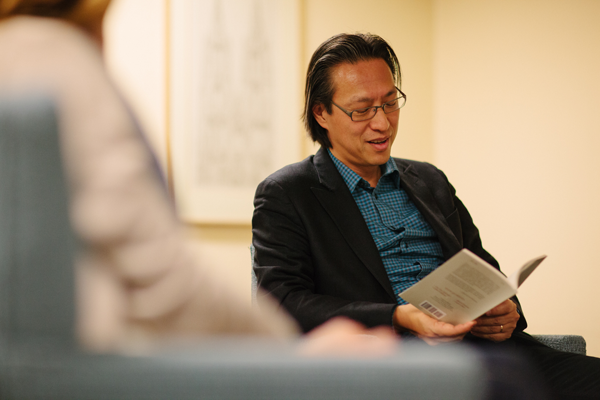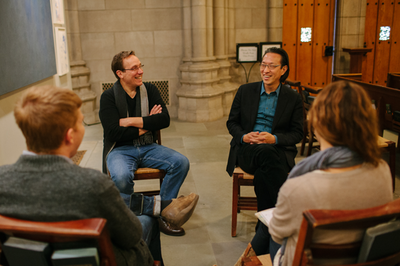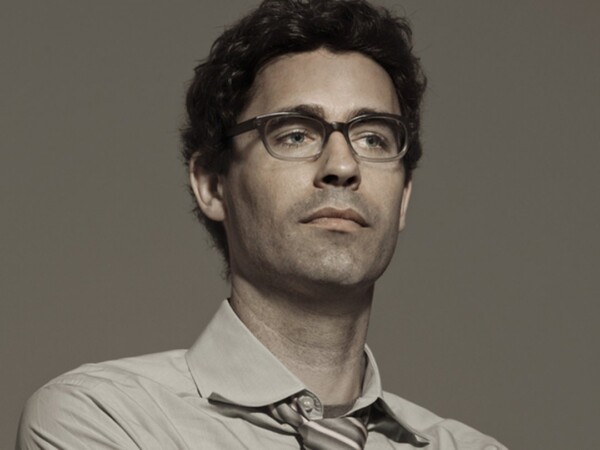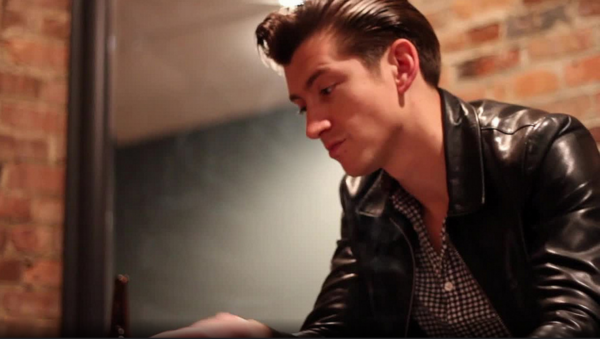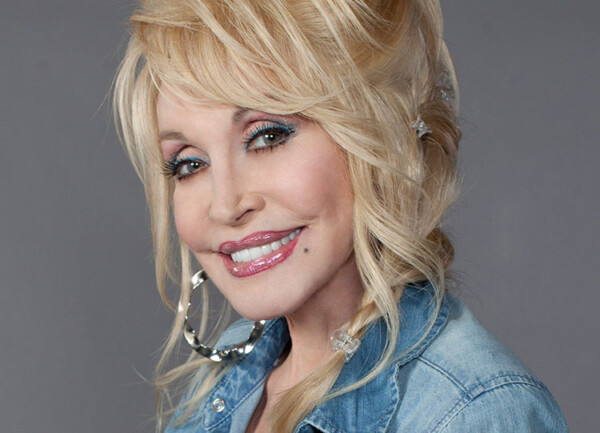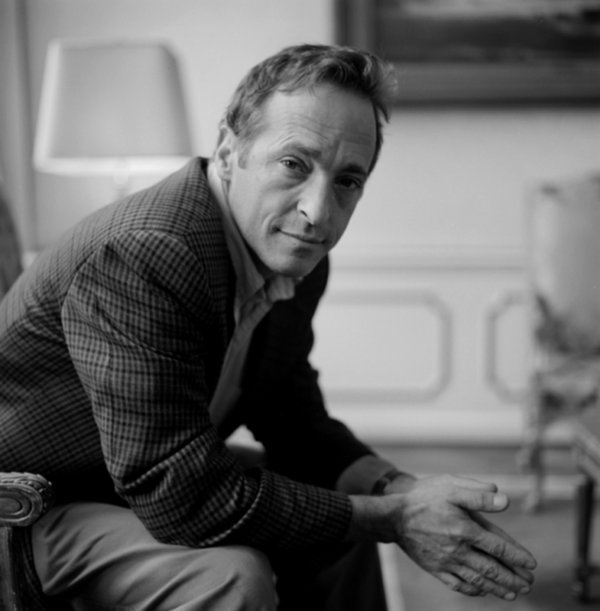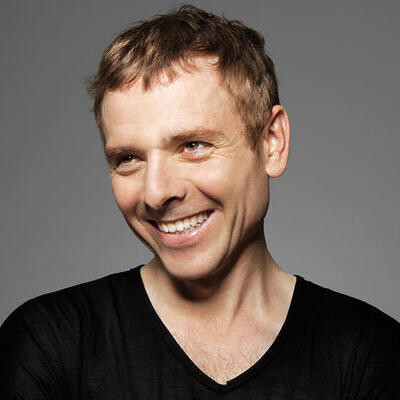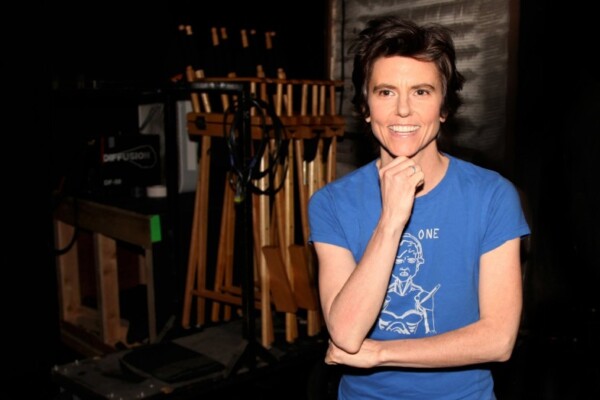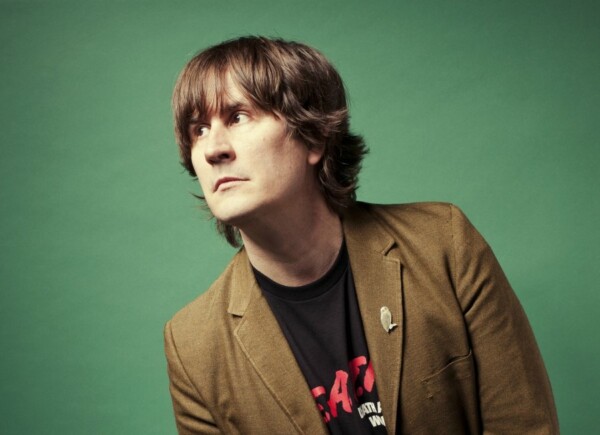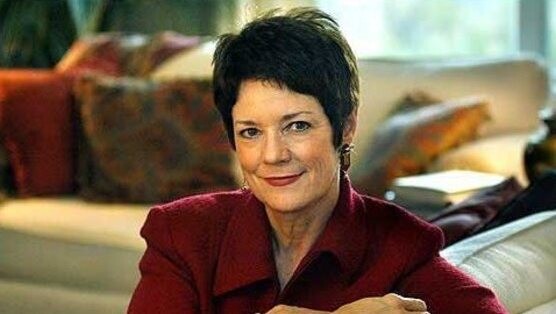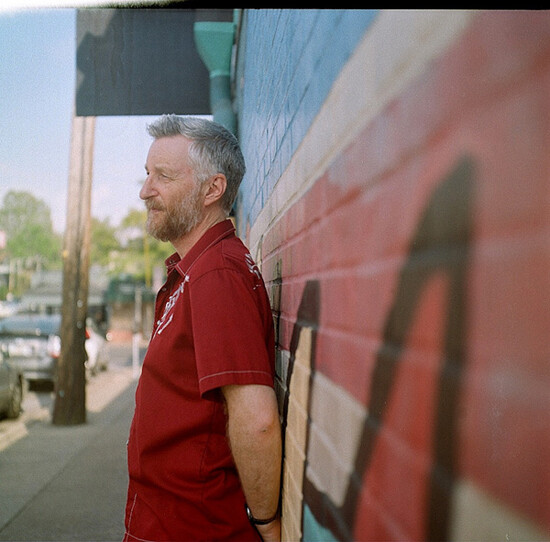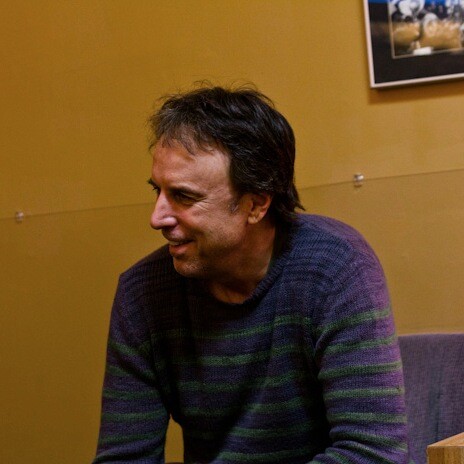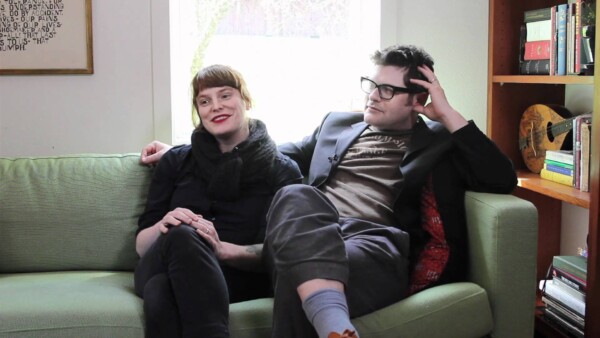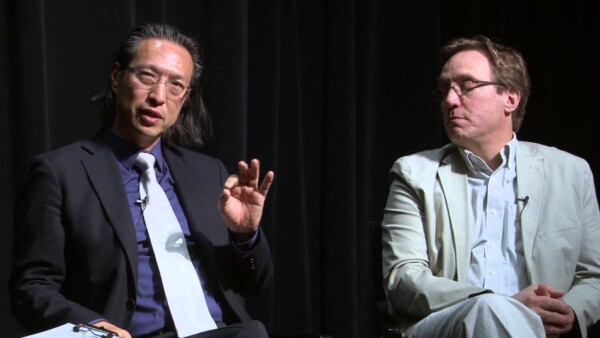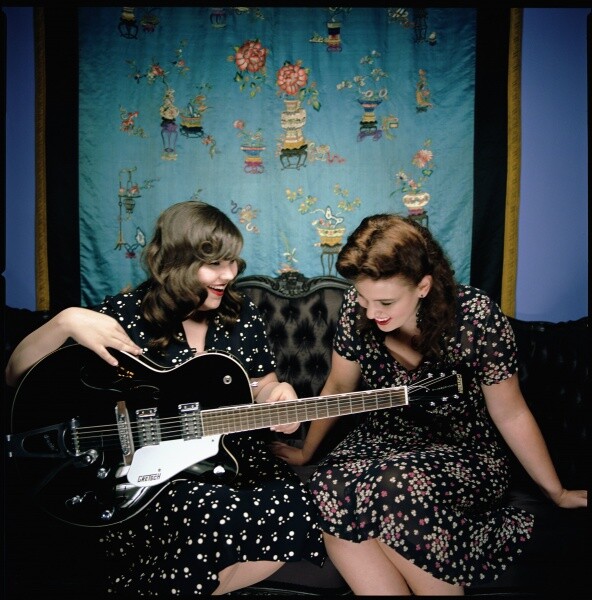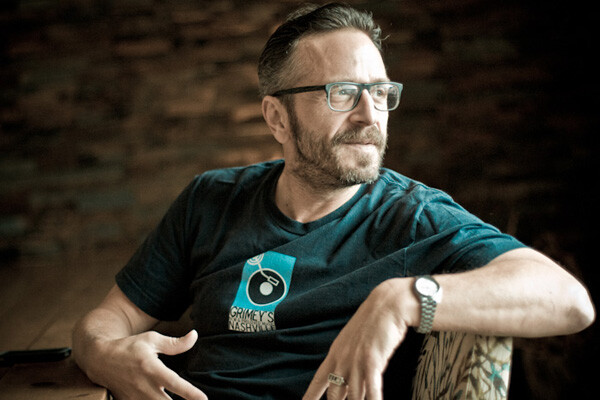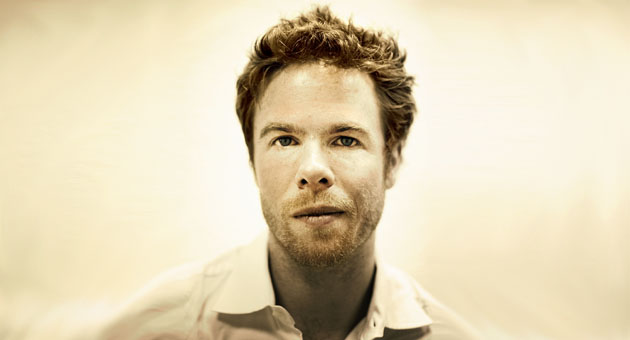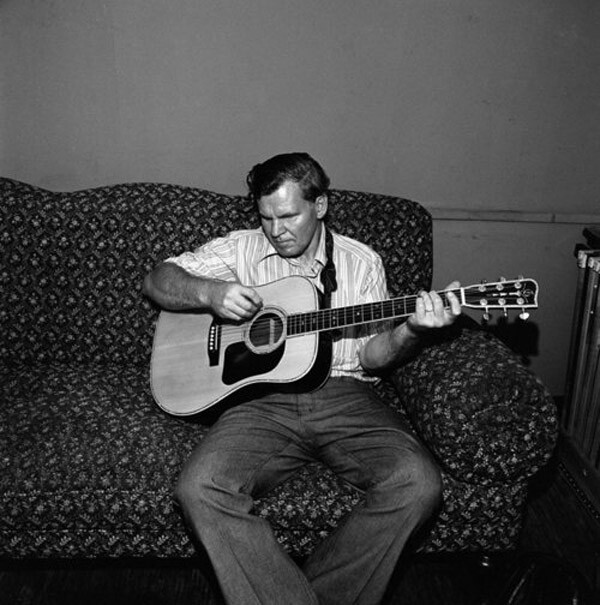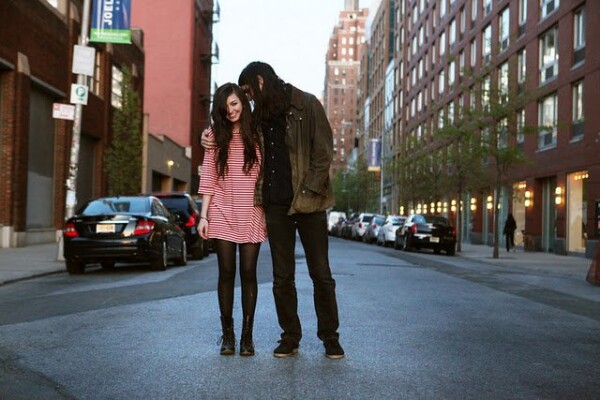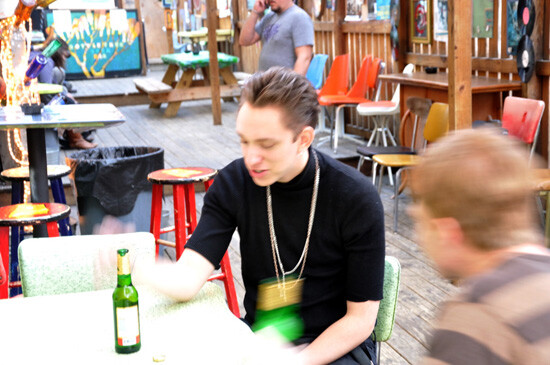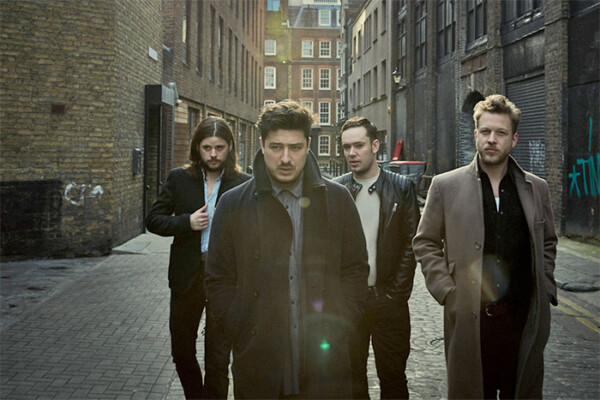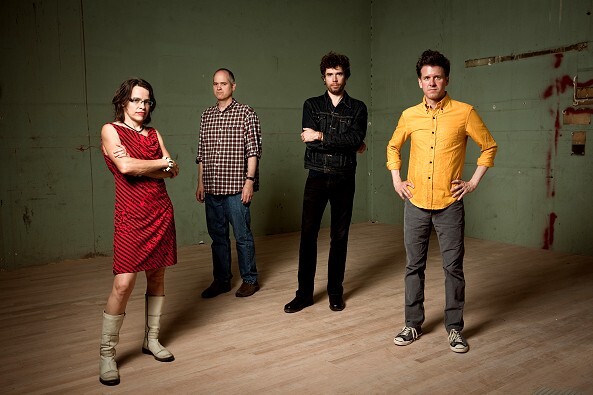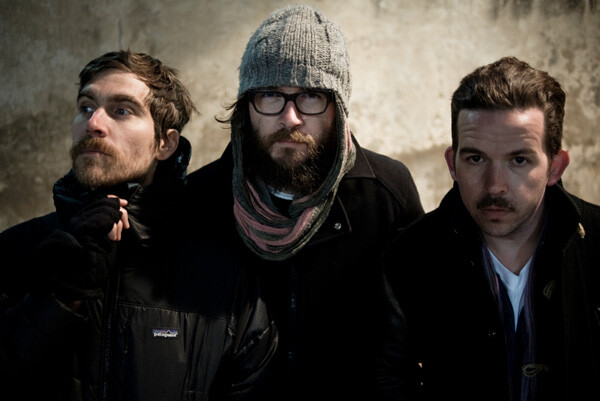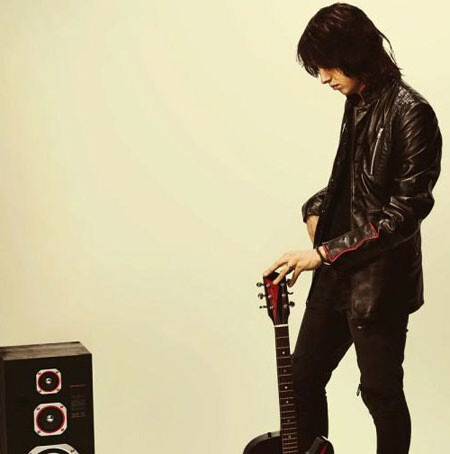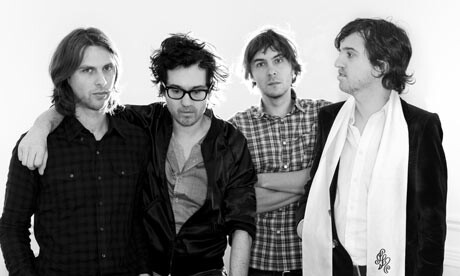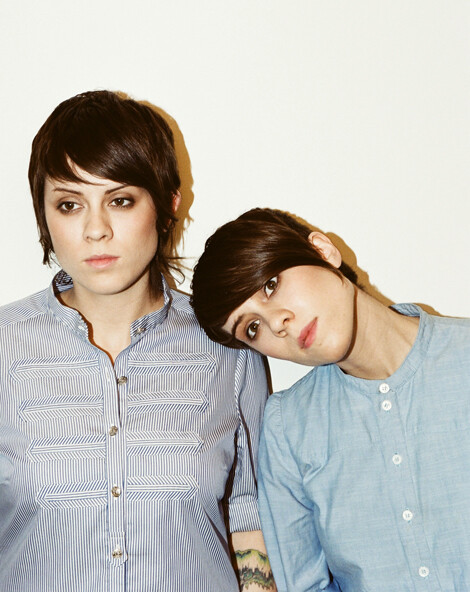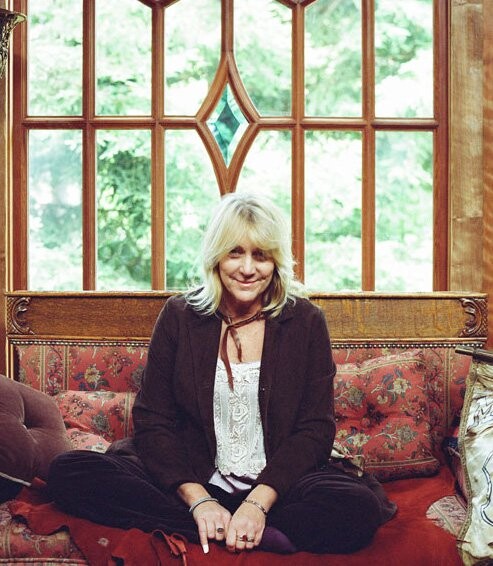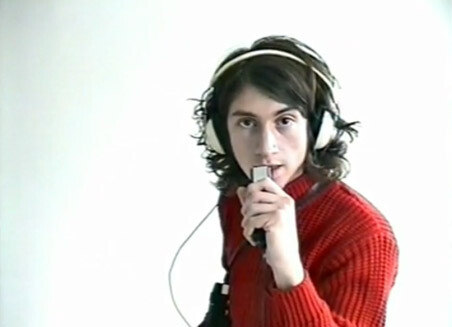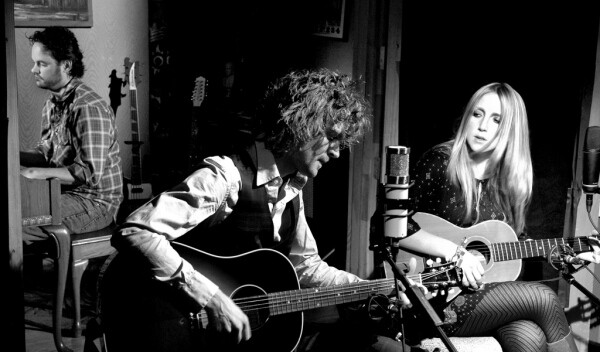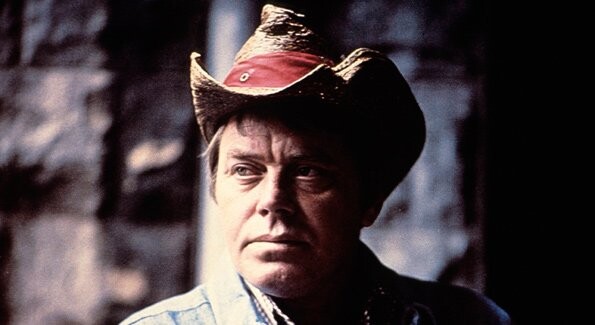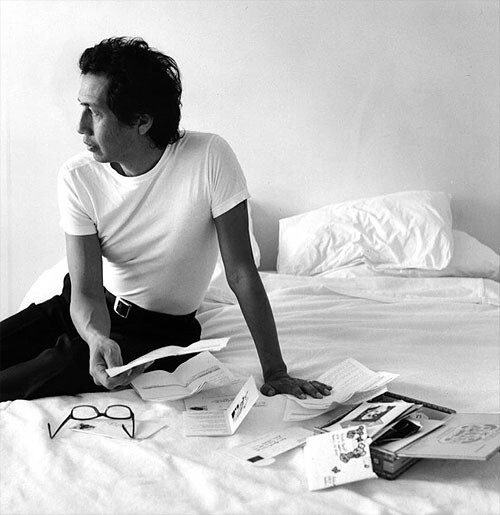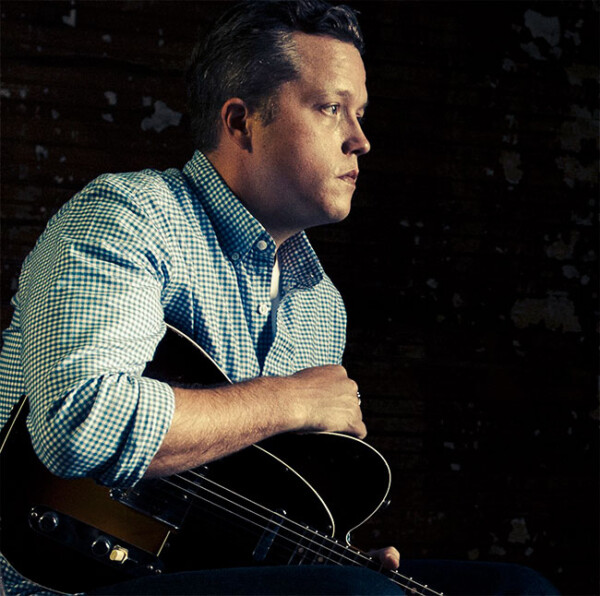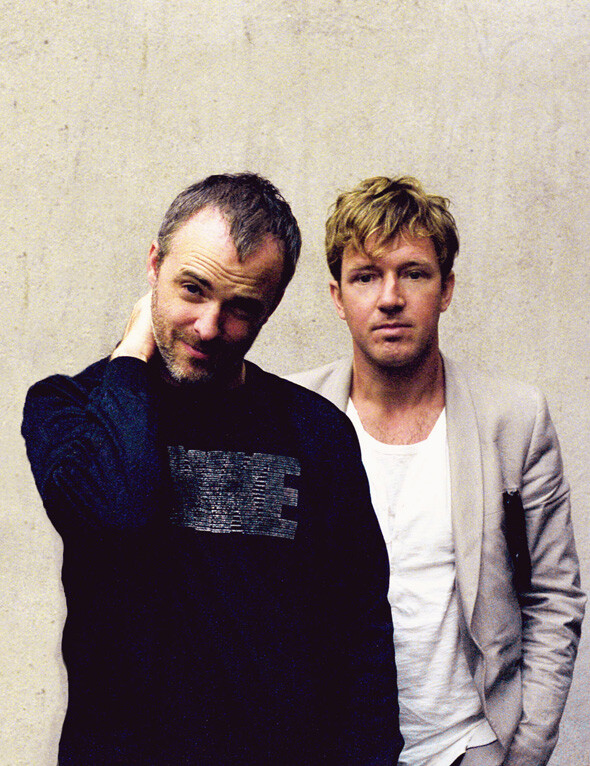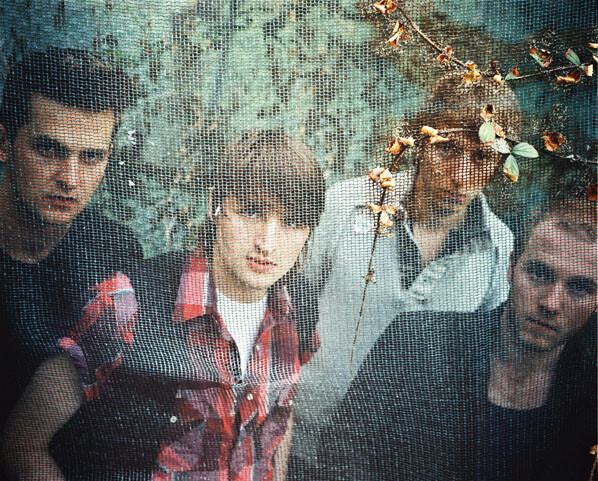‘Drinks With’ is an interview series started by Skip and Timshel Matheny in 2009. The interviews are almost always done in person and typically discuss the creative process. This interview is the first in a series for Paste of speaking with authors and visual artists.
Timshel Matheny met up with painters Makoto Fujimura and Bruce Herman at Duke Chapel earlier this month to discuss their current collaboration, Qu4rtets. The project is a collaborative response to T.S. Eliot’s ‘Four Quartets’ in 16 paintings, an original classical piece by contemporary composer Christopher Theofinidis and a series of critical essays by scholar Jeremy Begbie. There will be on exhibit at The ISM Gallery of Sacred Arts, at Yale University until March 8.
Â
Matheny: What is your favorite drink?
Herman: There is this red wine from Umbria, and I know the vintner. It is called Clanco. And you can only get in one wine store in the United States and in New York. But if you go to Umbria, if you go to Orvieto, you can get it there. And it is not expensive. It probably translates as a $20 bottle of wine although it tastes like a $200 bottle of wine. It just has this wonderful quality to it.
Fujimura: Well, since he went with wine, I’ll go with with wine. My 21grams, which is a project that kind of fell into my lap around five years ago. It is this winery in Walla Walla, Wash. They came to me and said that if I would donate an image then they would donate the proceeds to International Arts Movement, and so I said OK. And as it turned out this became this premium wine. This year my painting “Golden Sea,†which is my retrospective painting, is on the label. And it just looks fantastic on it.
Herman: You know you’ve arrived when your painting is on the label of a good bottle of wine.
Fujimura: [laughs] Right. I also like the process of wine, though. The process of waiting. And thinking about when the first bottle was mature enough to drink—it was my son’s graduation from NYU. So…you open these at a very special family occasion, and it [was] like really good wine.
Matheny: Can you talk a little bit about the genesis of this project, your relationship to this poem and why you chose to base these works around it? I know that you each have had a longstanding relationship with Eliot’s “Four Quartets.†Bruce, you have been reading it and re-reading it since college. And Mako, you have said that you picked up this poem as a kind of companion as you were experiencing the destruction and disorientation caused by the tragedy of 9/11, which occurred only blocks from your studio.
Herman: Yes, something that did lead to the genesis of this project was the mutual destruction that both of us had experienced. In my case the studio and house fire in 1997—being struck by lightening. And in Mako’s case, the 9/11 towers coming down. And living at Ground Zero.
Fujimura: Yes. Well, the person who introduced me to “Four Quartets†was my friend Greg Wolfe. It had been a very transformative poem for him. He had read it at Oxford while studying and then later it had played a role in his conversion [to Catholicism]. But I remember him saying that if you ever found yourself disoriented or lost in a dark woods, to read this poem. And that is why, after 9/11, I picked up “Four Quartets.†I wrote to him and said, “Hey, I think I’m ready to spend some time with this poem.â€
eliotproject15edit.png
Matheny: I love the fact that the materials you each use for your paintings actually decay over time: Silver leaf that oxidizes or ground-up pigments that shift with temperature and constantly react to their environment. And then as time goes by, because of these elements, there is a kind of transformation always happening, within the piece itself. Like the painting is never actually complete in some sense. Usually, as a painting or work of art is finished an artist must say “I’ve finished this. It is now in a frame, and placed on a wall.†However, with these paintings, the work is continually transforming and completing itself. As you each approached your work, attempting to process some profound moments of destruction and disorientation, how much of this were you aware of, or thinking about? Was there a conscious connection between the materials, the process itself, and what you were responding to?
Herman: Well, yes. In these cases [points to his paintings] there is literal destruction. In the painting “Autum/Water/Adulthood†I had a male figure by the tree there in the beginning, and I sanded him out. I literally sanded him right off of the painting. And then, while I was sanding him off I saw that the cutting right through down to the white ground looked like a cloud form. And it looked perfect for her. It just sort of rose up. And so I started just taking the sander to all of those other places. That’s what those white spots are..they are just missing pieces of the painting. It’s the same thing in Mako’s painting. He starts with that grinding of the mineral..pulverizing the mineral into something that can actually be used for color and paint. It is like a great metaphor for our lives, isn’t it?
Fujimura: Yeah. And not only that, it is not just that I am pulverizing the pigments…but then I heat them. So they must go through fire.
Herman: [quoting the poem] “From fire by fire.â€
Fujimura: So the azurite. What you are looking at is the same kind of azurite [in each painting] but a different tone of blue that you can only see if you let your eye stay with it a while. And it kind of opens up to you…like the wine. You have to let it breathe.
Matheny: You have to wait.
Herman: Yeah. And in that way, losing is finding. It really is.
Matheny: And so this transformation continues even into the exhibition process?
Fujimura: Yeah. The interesting thing about collaboration is that every exhibit that you are a part of, you do not get see the whole entire piece until all of the paintings are together. So, that is a level of discovery too. You know, even if you finish a painting ..it’s not finished. Until it is exhibited. And so there is this ongoing sense of process and completion that gets repeated each time we install the exhibit. Each time there is this unique presence in the paintings that gets particularized in the space. So we just kind of behold in wonderment what can happen with each exhibit. It is going to Yale after this to join my retrospective, and that will be a whole other experience. And then we add Chris [Theofanidis] into the picture—and it is just incredible.
Herman: His music is absolutely incredible.
Fujimura: Yes. I know we are completely biased, but I think it is one of the landmarks of classical music. Because, what I was thinking after the Baylor performance, “What song can you play after Newtown?â€
Herman: Yes.
Fujimura: You know? And after 9/11? There are very few pieces of music that you can play after those events. But Chris’ music, you can play that. Because it is disorienting. Because it’s fragmented, it feels right to play it. It’s a final breath. It just affirms what we are going through no matter how close you are to these events. And in this series of work, you know, I think the East Coker passages may not be my favorite, but they are certainly the most important passages in “Four Quartets,†when [Eliot] speaks about the darkness. And that is why these [points to his paintings] are so dark, because that darkness is, to me, the most significant part of my own recognition of a voice that has experienced darkness—and is now affirming what I was going through. And therefore it was just comforting. Throughout the tour we speak to people about “Four Quartets†and their experience of reading it, and most of the time they say things like, “You know it is the most disorienting poem. It is so disjointed and fragmented,†and I think, “No! It is the most comforting poem.†And then I go back to read it and I think, “Wow, this is really disorienting†[laughs]. I think when I was reading it and I was going through post 9/11 trauma, it was comforting because it was disorienting, you know what I mean? Chris’ music works like that.
Herman: Yeah. The voices that you hear in the four movements of Chris’ piece are voices which I think most people would associate with pain. But I think there is, in the second movement in particular, a rising. The violins and the viola and the cello are all up in this upper register, and then the piano is dropping this slow descent. [He is] using the same aural materials that he has begun the piece with. And it is so poignant.
Fujimura: It is doing this drip.
Herman: Yes. This sort of coming down, coming down and coming down. And as he explains in his program notes, the grid that we have set up as you can see in Mako’s piece [“Quartets IIIâ€] and in all three of mine, the grid is actually dissolving. Like the tick-tock, tick-tock of chronological time which is always playing out, is always breaking down. But there’s another kind of time. There is time that has a storyline. A Kairos. Which it can slow down. It can speed up. It can disappear. You can penetrate into it. Like [C.S. Lewis’] Narnia, you can go through this magical door and suddenly you are in a different time period. Chris’ music has captured that feeling of the breakdown of time and it’s falling away and then there is this surprising re-entry of hope. In the midst of these painful kinds of chaotic sounds.
Fujimura: Yes. You know we both, when we first heard it in bits and pieces, it was kind of like this strange experience because we recognized our paintings in his music. And he did such an amazing job bringing these things together. We didn’t even know this guy.
Herman: We didn’t meet him until we started on this project.
Matheny: How did you decide to work with him?
Fujimura: He was recommended to us.
Herman: Everyone we had consulted agreed that Theofanidis would be the best fit for the project. It just emerged. And then we got a chance to meet Chris. I asked if he would be interested and he said, “Definitely.†We had just a little bit of correspondence. I went out and bought some of his music. His most famous piece, “Rainbow Body,†is just incredible. It might be the most-played piece of classical music by any living composer. They played it at Baylor, and I just wanted to jump up and shout. But in the middle of it you feel like your heart’s breaking. It’s just amazing.
Fujimura: At Baylor they have this student symphony, and they played this piece for the exhibit. And at the end, for the final climax, they started shouting. All of the students [in the symphony] just started shouting.
Herman: The screaming is actually part of the piece. It’s written into the music. So the violinists are shouting.
Fujimura: Yeah. And there is just this joy…
Herman: It’s just a total affirmation. It is a giant “yes.â€
Fujimura: Yes. Of life. Like a life force. It reminded me of what I imagined Aslan would sound like. Because there is this “grrrrr†and you don’t even know what is happening.
Herman: It’s almost like a howling at first. Yeah, I thought they were angels at first. They created such weird overtones on top of the instruments, I was like “where is this even coming from?†It was so bizarre.
Fujimura: Since the composer is there working with these students they will do that. When it is played at the symphony, that won’t happen.
Herman: They won’t do it. Even though it is written into the music.
Fujimura: Yes. But this is what Chris is like. He loves students. And he loves that youthful, inexact reality, and he wants to bring that out. And what composer does that? It is amazing.
Herman: He is also humble enough that he will let the musicians that refuse be and he won’t push it. He is not a prima donna. He is really a humble man. He’s young…he’s like what? 45? [laughs] We think that’s really young. I mean, as painters, if you live long enough, you don’t even really hit your stride until you are 50.
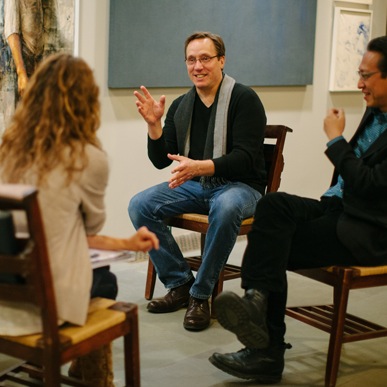
Matheny: Why did you choose to incorporate Mako’s father as the figure for this particular painting?
Herman: Well, it was an intuitive choice. You’re musicians, so you get it. A lot of things go into the choices we make. I mean, I could give you an elaborate rationale. But, the fact is, it was a heart thing. I had breakfast with Mako and his dad one day when this project was just incubating. And there was just something about his face. And his spirit. His conversation was minimal. Like some sage, zen master.
Fujimura: [laughing] Yes. He doesn’t say much.
Herman: I’m sure he can open up when he needs to. But it wasn’t needed at that moment. Probably because I was doing way too much talking.
Fujimura: Well, and he had no idea that we were working on this project either. I had talked to him about the Institute and that I wanted to honor his legacy. To give you a background on him, he is a premier research scientist. I was born in Boston because he was doing his MIT post-doc research with Noam Chomsky. So he was on the front lines of acoustics research for the past 50 years. As a scientist, he recognized that there was disintegration in the scientific discovery process, assumptions that are really reductionistic that can not account for the humanness of speech and languages. I think he, without knowing, instilled in me this sense of need for integration in a very modernist world where things get categorized and specialized. And he lived his life to counter that, really. He would come home and play the quartet with his scientist buddies. He picked up the viola because no one wanted to play the viola…he just learned it. He’s an extraordinary person, and I think that [breakfast conversation] was kind of the beginning of us really implementing what we had dreamt for a long time.
Herman: Right. I mean I’m sitting there at breakfast…and I had already started this painting [points to the painting “Spring,†which features a young boy, siting alone in a tree], and it had four children in it, not one. The other three children are still there, you just can’t see them. I dare you to find them. They are “hiding in the foliage.†[laughs] The foliage in this case are leaves of gold or silver. Literally gold leaf or silver leaf.
Matheny: [laughs] That is incredible.
Herman: So they are sort of buried under there. That piece was underway. And I was thinking that the next piece had to be “Winter.†It had to be the final piece. Rather than doing the other two in sequence. And so I was in New York with Mako and I’m thinking, “What am I gonna do for this painting?†And I was sitting there at breakfast and it just dawned on me. So I asked Mako, “Do you think your dad would be offended if I asked him if I could paint his portrait?†and he said, “No I don’t think so.†So Mako actually went to Japan to photograph his father for me. I took pictures of myself in the right position [laughs] and gave them to Mako so he could pose his dad. It was an elaborate process that was completely crazy.
Matheny: In your promotional video for this Qu4rtets project, you describe his face in this particular painting [“Winterâ€]: “The figure of Winter, standing for that stage of life where we’ve aged and have begun to become one with our life, really deeply living into our face.â€
Herman: Sure, yes. Every artist is motivated by different things. And as a little child, the thing that got me started as an artist, as a 6-year-old little kid, was looking at my grandparents’ faces. I didn’t have the language to explain it at the time but I saw the history of their entire life in their faces. So from then on I was drawn to old people’s faces in particular, but faces in general. And also, in particular, hands. And so, of course Rembrandt—the first time I encountered a work of art [when I was young] it was a Rembrandt. And I was just absolutely dumbfounded by the fact that he could not just paint an effigy or some “likeness†but it was the person that was radiating from the painting. Their presence. The real presence. And of course, now as a theologically more sophisticated person than I was then, I can talk about real presence as the “Real Presence.†So for me, sitting there at breakfast—it’s always at the table isn’t it?—the best things happen at the table. [laughs] The best things. Sitting there having breakfast, the three of us are sitting around the table and because the three of us need to eat, we are all weak, we are all dependent creatures, and our guard is down. I actually think that is why Jesus used bread and the wine. The most common elements that we all need. We need to eat. We need to drink. We need a little help from our friends, to quote some famous people.
Matheny: I find it interesting that so much art is also trying to create that moment of vulnerability or “being pulled out of yourself†that you describe happening at the breakfast table. Often times art or more specifically entertainment uses grandiose elements of violence or exaggerated details in order to pull people into a moment of engagement and reaction. But it dissipates. It often doesn’t seem to create a lasting effect or change in the individual. The two of you, however, have created a space or a “still point†in your exhibit that works more like a seed. It begins an encounter and then expands over time.
Fujimura: Yes. And you know I have been thinking about that idea of a “still point†[a repeated phrase in “Four Quartetsâ€] for a very long time, ever since 9/11. And I tried to depict that in my work. In the four that I painted, the still point is the black. It’s the gesso that is used. My assistant Lindsay and I wrestled and experimented with different ways of doing this and we kind of settled on this particular mixture. It has a lot of mica in it, and so it is refractive. So those two panels, they are not the same. They have layers and layers of different compositions of refractive elements in them. So, you know, if you spend time with it you start to see that even though it is black, it is shedding light. It is kind of this meditative idea of, you know, St. John of the Cross…it is the stripping away of everything, and what do you get? I wanted to create a gesso that really spoke to that process.
Herman: We didn’t talk about this but you said that the still point for your pieces is the black gesso, but the still point in my work is the literal ground. It’s traditional gesso which is marble dust and hide-glue. But then it’s the clay. The black clay in this case. Or the red clay in the other case. It’s funny, when we were talking about wine, we were talking about waiting. This poem that has pointed us towards stillness and waiting—the heart of Chris’ music and the heart of this poem.
Fujimura: Yes.
Herman: [Quoting the poem] “We are only undefeated because we have gone on trying.†and “Wait without hope because hope would be for the wrong thing.†And it is all in the waiting.
Matheny: How long does your friendship go back? So this conversation, when did it start?
Fujimura: It was two years after the fire for you [to Bruce, in reference to a fire at his home, which burned down his entire studio with his works in it].
Herman: So it would be 1999. And our work has been in conversation all those years as well.
Fujimura: Well I think it was at a CIVA meeting and they had mentioned “pray for Bruce.†And I had never met you. I was new back in the country, and I came back and wanted to connect with other artists of faith. And I think it was my first meeting and they talked about you, but you weren’t there. So I didn’t know Bruce at all, but I heard the story and thought “Oh, I can’t imagine losing your house, your entire work, you know…†So I am praying for this artist, and two years later we meet. And I said, “Nice to meet you. I’ve been praying for you. How are you doing…†[laughs]. And he said, with this grin, “Oh that fire was the best thing that could have ever happened to me.†And I thought “OK…†[laughs loudly] “Who is this guy?! I need to get to know this guy.†I didn’t know what to say.
Herman: [quoting the poem] “In my end is my beginning.†Yeah. And so that is how this journey began. Last time we were speaking in Dallas during this interview on stage and it just occurred to me that we probably wouldn’t have journeyed together if it wasn’t for fire.
Fujimura: Because there is just no reason. I mean, we would still be good friends, but…
Herman: Yeah. I think it was fire. And I think when you and I really connected was after 9/11 when you were itinerant and displaced and dislocated, and you and your family came to stay with us at our rebuilt house which we had only been living in for a year. Before that we were acquaintances, but after that we were friends. And I think our friendship deepened during our conversations at that time and after that point. I also think that it was after my fire that I finally, in terms of my own work [pauses] whatever it was that I was hanging on to, I got over it. It got burned away. And whatever I was hanging on to, was not just the physical [paintings] but…how do I say this? I think we all go through this as artists on some level—my fear of—No. Let me say this differently. No, it’s not so much a fear. We’re taught in our culture, and especially in the art culture, that originality is the most important thing.
Fujimura: Right.
Herman: But the trouble with originality is that it becomes a shibboleth. It becomes a kind of a password that is supposed to get you into greatness. But it doesn’t. It actually pulls you back. And it’s really humility that gets you closer to greatness because you become open to genuine dialogue. And so it’s not about you anymore. It’s not about you making a name for yourself. It’s not about being original. It’s about really looking, really finding your way into genuine conversation. And that was the point—after the fire—that I began to consciously allow colleagues and my friends who were artists to influence my work. I mean, just to welcome them into the work. The word “influence†isn’t even the right word. It’s more to be part of a conversation with their work in a conscious way rather than trying to fend it off saying, “Well, I don’t want to be influenced by this guy or this woman or this great artist or whatever.†And I stopped even thinking about the whole concept of influence. Who cares?
Fujimura: Yes.
Herman: There’s no original work of art on the planet. Except the planet itself. And us. Anyways. That’s a long digression but I think what I am trying to say is that is when I began to really enter into conversation with you [to Fujimura] as an artist and with your work. That is also when I was able to enter into conversation with other artists as well.
Matheny: I know that it is very true for any creative artist that the ability to find your voice and identity seems to be of utmost importance, almost an essential development, especially in the beginning of a career or vocation. Was this perspective or this new ability to move past “yourself†a possibility because you were further along in your career, established in some part, and all of that other ridiculousness could be out of the way?
Herman: Yeah. Well, I’ve got a story, and Mako, I don’t think I have ever told you this. When I was in grad school I studied under this American painter, Philip Guston. He and Jackson Pollock were close buddies and together moved from L.A to New York. Jack went a year earlier, and then Phil followed him to do work later on the WPA murals. And it was their conversations that really got Abstract Expressionism fired up and going. There were a bunch of others who were part of that conversation too. People like Bill de Kooning and Franz Kline. But Phil was sitting one day in our graduate studios and chatting with us. The studios were in this dusty old Cadillac warehouse, and it was really grimy. We’re all sitting on the floor because there was only one chair. So Phil’s sitting on the chair chain-smoking. And he’s leaning forward and he goes, “So, you all wanna know what painting is?†And we were all thinking, “What are you talking about? We’re graduate students. We have been painting for a while by now. What?†And he says, “Y’all wanna know what painting is? This is what it is: You go into your studio and everybody’s in there. Francesco Goya is in there. Vincent Van Gogh is in there. Rembrandt sittin’ over in the corner saying ‘Yeah sonny, let’s see what you can do.’ Marie Cassatt is over there. They’re all in there. All the great masters are in there. And one by one they get bored and they leave. [pauses] And then—when you leave—that’s when you’re painting.â€
Fujimura: [laughing] You’ve told me that before, but that is great stuff.
Herman: The thing is,…and this is what I think is relevant to what you were just asking, then he leans forward and he goes, “So, the whole thing is, the whole thing…†And he keeps repeating that, “The whole thing, the whole thing—is totally abandoning yourself.†And I could’t help myself because I am this little 25-year-old grad student, and I go, “So Phil, that’s great for you to say because you’re a master. So I’m gonna abandon myself? I mean, I hardly even know my ass from my elbow. How am I gonna abandon myself?â€
Matheny: [laughs] Right, what’s there to abandon yet?
Herman: Yeah! I don’t have anything to abandon yet! I don’t even have a self to abandon yet. And he looked at me and he said, “You changed the subject.†[pauses] Basically he said, “This isn’t about you.†And then of course you spend your life figuring that out. That this isn’t about you. This thing is not about you. Guston is the one that introduced me to “Four Quartets.†He loved “Four Quartets.â€
Matheny: Even when you are abandoning yourself, as you have described, you are still the operator who is executing the work. And so how do you know when you have to come to a point where you do actually finish a painting and say, “here it is, I am done� You each work in a particular medium where the painting itself is always changing, and so how do you know when it is finished?
Fujimura: When you are young you try to put everything into your painting and say, “This is my master work and it’s gonna change the world!†[laughs] And you slowly discover that it can’t. And the best way—you know C.S. Lewis talks about it—learning to love the boundaries and limitations that you are given. I was very fortunate in that I discovered very early on, that compared to my peers at my school, art majors or even as far back as high school, that there are thousands of people that can do things better than me. I discovered that there is this one particular area that I am really good at. That I took for granted for many years. A kind of slice of expression that has to do with gesture and how you see things. How you accentuate what you see into kind of a calligraphy. I’m really good at this one thing. I can do it in my sleep. And when I discovered this, I was very fortunate because I spent my lifetime developing and focusing on that. And I accepted my limitations and thought, “I cannot be this person and I can’t be that person, but… And that is why I really do appreciate the people that can do the things that I can’t do. Like Bruce. He can do things that I can’t do. So, my excuse for collaborating is, [laughing],…like “You do it! You paint my father’s portrait. Because I can’t do it as well as you can.â€
Herman: And the thing is, I can say the same thing. I mean, there is an element in your work, Mako, that actually, it’s almost like a vitamin deficiency that I have. But you have in abundance. And I think I can almost name it. Um, I’m gonna give it a try. I’ve never tried before: It’s visual silence.
Fujimura: Yes.
Herman: And it’s a hunger that I have, but it’s almost like a missing piece in my make-up as a man, as a thinker and as an artist. And I’ve known that. I’ve known that for years. But like you said, you’re stuck with who you are and the medium [you are working with]. You know, it’s interesting to me that Jesus said to his disciples, “Let your light so shine before me that they see your good works and give glory to your father in Heaven.†He doesn’t say, “Let the light shine through you.†It’s “let your light so shine.†It’s one little limited thing. And that is all that you have to be. And as soon as you can get over your envy of others or your wishing that you had some other person’s gift, then you can actually do something.
Fujimura: Yes. Right.
Herman: And then, you put two of you together, or three together, like we are working with Chris [Theofanidis] and it’s like a fire starts erupting.
Fujimura: To answer your question, I mean, I say that because I know my limitations and I can do things in such a limited capacity that I don’t want to presume that I can finish a painting. I wan’t to make it pregnant; full of potential. And I will say that the most successful painting is a painting that gives birth to ten other paintings. And I’ve spent my whole lifetime trying to do that. And so they are generative. They grow out of each other. I suppose my success is due to the fact that I have limited myself to one particular area. So I never have creative burnout. Because I don’t have enough time in my life to complete all the works that have just generated out of the works that I have done in the past. And this particular collaboration is one of these collaborations where, you know, I write it in the catalogue, “Collaborations should give each other courage,†to experiment, to go places you’ve never gone before. And I did. Because Bruce was there I was imagining Bruce painting these paintings. I saw some of the paintings in progress. He was kind enough to send some of the pictures to me. I didn’t reciprocate but—
Herman: What could you send me? It’s like sending me a box of air or something.
Fujimura: Yeah, exactly. Water or something.
Matheny: He sent you decibels of sound in a sealed envelope.
Fujimura: Yeah. [laughs] I was imagining Bruce doing these works and we’d been journeying together enough for me to know the direction that he wanted to go. I wanted to create my piece so that they would literally serve his pieces. So they would become this sort of yin and yang. And I wanted to push mine to such an extreme so that there was nothing left but that. So it’s not about me. It’s not about self-expression. It’s about “How do I place myself in the service of the text? In the service of Bruce? And then later on, Chris?†I wanted to be part of a whole. And so, at one point Lindsay came in, my assistant, and she had gilded some of the pieces that I had worked on it. And I was frustrated with this one part so she was helping me figure it out. And she came in one day to the studio and it was that gold-paneled piece [“Quartets IIIâ€] and it was like all of the sudden she saw it and she goes, “Oh.†And I said, “Yeah.†And that’s when I knew that I’d got it. Because she is someone that I’ve journeyed with even more closely. She did all the gessoes, you know. And she saw the miracle; the something special about that piece. And so, once one piece is so-called “completed,†then you know that in comparison to the other pieces they are co-inhabitants of the same sphere. And they needed to be that so that it was easy to figure out. Projects like this work like that.
Herman: It worked exactly the same way with the four paintings that I did for this project. The painting of the child in the tree (“Springâ€) which was originally four children. When I realized that three of the children had to disappear was when [I was] covering them with silver, which was actually that moon gold which is a kind of cross between silver and gold. That is what gave birth to the painting of the old man (“Winterâ€). The four paintings only come to conclusion together. Some people might be able to map out how to complete a painting. I never can. For me it’s always that moment where it clicked in and to even add a stroke is to undo that kind of dynamic equilibrium that you’ve arrived at.
Fujimura: And to tell you the follow up, out of these paintings—the three large paintings at Yale that are in my retrospective right now, they are called “Walking on Waterâ€â€”they’re the three that came out of these paintings. Literally they were generated out of the paintings that we did for this project.
Herman: I can’t wait to see them.
Fujimura: And you can see not only the influence but, also, what collaboration can do to really fuel the future of your own expression. Not only were there 10 paintings, there were probably thousands of paintings that could have come out of this. I mean, that’s not an understatement. I could spend the rest of my life figuring that out.

